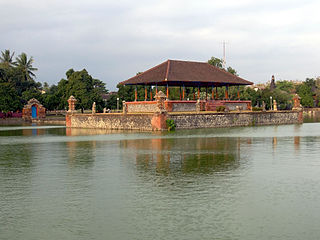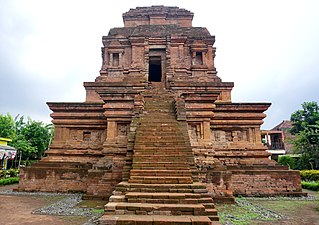
Prambanan is a 9th-century Hindu temple compound in Special Region of Yogyakarta, Indonesia, dedicated to the Trimūrti, the expression of God as the Creator (Brahma), the Preserver (Vishnu) and the Destroyer (Shiva). The temple compound is located approximately 17 kilometres (11 mi) northeast of the city of Yogyakarta on the boundary between Central Java and Yogyakarta provinces.

Malang is a landlocked city in the Indonesian province of East Java. It has a history dating back to the age of Singhasari Kingdom. It is the second most populous city in the province, with a population of 820,043 at the 2010 Census and 843,810 at the 2020 Census. Its surrounding is home to 3,663,691 inhabitants in 2010, spread across two cities and 22 districts. Malang is the third largest city by economy in East Java, after Surabaya and Kediri, with an estimated 2016 GDP at Rp. 44.30 trillion.

A step pyramid or stepped pyramid is an architectural structure that uses flat platforms, or steps, receding from the ground up, to achieve a completed shape similar to a geometric pyramid. Step pyramids are structures which characterized several cultures throughout history, in several locations throughout the world. These pyramids typically are large and made of several layers of stone. The term refers to pyramids of similar design that emerged separately from one another, as there are no firmly established connections between the different civilizations that built them.

The Manjusrigrha inscription is an inscription dated 714 Saka, written in Old Malay with Old Javanese script. The inscription was discovered in 1960 on the right side of stairs entrance of Sewu pervara no. 202 on west side. This inscription is linked to Sewu temple. According to this inscription, the original name of Sewu temple compound is probably Manjusrigrha. Sewu temple is located approximately 800 meters north of Prambanan temple, Central Java, Indonesia. The inscription was carved on an andesite stone block measured 71 cm x 42 cm x 29 cm.

Cultural properties of Indonesia are those items defined by Indonesian law as of "important value for history, science, and culture", and include both man-made artefacts and natural objects. The cultural properties number more than 8,000 and include ancient Hindu and Buddhist temples, mosques, historic colonial buildings, forts, art galleries, national parks and beaches. A number of the sites are World Heritage Sites.

Kadisoka is a partially excavated temple, thought to be Hindu, in Sleman Regency, Special Region of Yogyakarta, Indonesia. It is listed as a Cultural Property of Indonesia.

Prajñāpāramitā of Java refer to a famous depiction of Bodhisattvadevi Prajñāpāramitā, originated from 13th century Singhasari, East Java, Indonesia. The statue is of great aesthetical and historical value, and is considered as the masterpiece of classical Hindu-Buddhist art of ancient Java. Today, the statue is one of the prized collection of the National Museum of Indonesia, Jakarta.

Gunung Wukir temple, or Canggal temple, or also known as Shivalinga is a Shivaite Hindu temple dated from the early 8th century, located in Canggal hamlet, Kadiluwih village, Salam subdistrict, Magelang Regency, Central Java, Indonesia. The temple dates to the year 732, making it the first structure attributed to the ancient Mataram kingdom, which ruled Central Java from 732 to around the middle of the tenth century.
Arca Totok Kerot or Recå Thothokkerot IPA: [rətʃɔ ʈɔʈɔʔ kərɔt] is a statue located in Bulusari Village, Pagu District, Kediri Regency, Indonesia; about 2 kilometers north-east of Simpang Lima Gumul. It is made of andesite stone, depicting a giant with a terrifying face. The style is that of a dvarapala. Based on the style, it is suggested that it was made in the 10th century.
The Madiun River is a river in East Java, Indonesia, about 500 km to the east of the capital Jakarta. It is the largest tributary of the Solo River. Its name indicates that it passes through the major city of Madiun, East Java, Indonesia. This river starts as a number of smaller tributaries converging near the city of Ponorogo, in particular the Kali Slahung, Kali Keyang and Kali Sungkur. It eventually converges with the Solo River near the city of Ngawi.

Al-Wustho Mangkunegaran Mosque is a historic mosque located in the Central Javanese city of Surakarta, to the west of the Mangkunegaran Palace. The mosque is one of the three oldest mosques of Surakarta. Al-Wustho Mangkunegaran Mosque was inaugurated as a state mosque of the Mangkunegaran Palace.
Banten Girang is an ancient settlement located in Sempu village, Serang city, Banten province, Indonesia. It is located by the Cibanten River about 10 km south of the port of Banten, on the southern outskirts of Serang town. In that place there is an archaeological site which estimated dated to the era of Sunda Kingdom between 932 and 1030 CE. The term Banten Girang, meaning "Banten-up-the-river" referring to its location.

Mayura Park was built by Anak Agung Gde Ngurah Karangasem in 1866, located 2 km east Mataram.

Bubrah is a 9th-century Buddhist temple located within the complex of the Prambanan Temple Archaeological Park, in Central Java, Indonesia. Experts believe that the temple was designed as a part of the greater Sewu temple compound.

Gunung Gangsir is an 11th-century Hindu candi (temple) located approximately 5 kilometers west from the town of Bangil. This red brick structure is located in Gunung Gangsir village, Beji subdistrict, Pasuruan Regency, East Java Indonesia.

Sumberawan is a Buddhist stupa located in Toyomarto village, Sumberawan subdistrict, Malang Regency, East Java, Indonesia. The stupa is located in the highlands, on the southern slope of Mount Arjuno, surrounded by numerous Springs.

Roti gambang or ganjel rel is an Indonesian rectangular-shaped brown bread with sesame seeds, flavoured with cinnamon and palm sugar.

The Tomb of Ratu Mas Malang is a tomb and cultural site located in near the village of Plered in the Bantul Regency of Indonesia. It is the tomb of Queen Malang, one of the wives of Amangkurat I of Mataram. The tomb was built using white stone, and construction finished in 1668. The tomb has since been damaged by environmental factors.
Bumiayu temple compound, or locally known as Candi Bumiayu, is a Sumatran Shivaist Hindu temple complex located near the banks of Lematang river, precisely in Bumiayu village, Tanah Abang district, Penukal Abab Lematang Ilir Regency, South Sumatra, Indonesia. The temple located about 120 kilometres west of Palembang city. The red brick structures are estimated dated from 8th to 13th-century, and linked to the Srivijaya kingdom. Compared to Java, only a few Hindu-Buddhist temple ruins has been rediscovered in Sumatra. The temple is known as one of the few surviving Hindu temple remnant in South Sumatra. Other temple ruins in Sumatra are Muaro Jambi in Jambi, Muara Takus in Riau, and Bahal temple in North Sumatra.

Tarawangsa is a traditional Sundanese musical instrument from West Java, Indonesia, in the form of a stringed instrument that has two strings made of steel or iron wire. Tarawangsa is an ensemble of chordophones of two musical instruments. One is called tarawangsa itself, played by swiping and the other is called jentreng played by picking. The art of Tarawangsa is performed in the Ngalaksa ceremony, which is a ceremony for abundant harvests. The ceremony in the traditional agrarian society of the Sundanese is always identified with the figure of Nyai Sri Pohaci or Nyi Pohaci Sanghyang Dangdayang Asri or Dewi Asri or Dewi Sri as the Sundanese goddess of rice.



















